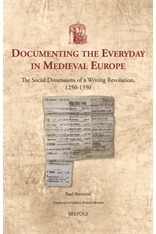Paul Bertrand, Documenting the Everyday in Medieval Europe: The Social Dimensions of a Writing Revolution, 1250-1350 (Turnhout, 2019: USML 42), xxiv+493 pp. ISBN 978-2-503-57990-0.
This book explores the complex relations between the written word and medieval society by focusing on the proliferation of administrative and business documents during the so-called ‘long thirteenth century’. It deals with northern France and the area covered by the historic Low Countries, but places these regions in a broader European context and in the general history of literacy.
Based on an exhaustive first-hand analysis of numerous archives and many document types, and featuring over a hundred illustrations, this book presents the reader with a large sample of documentary sources. But it also presents important hypotheses regarding literacy and the sociological dimensions of writing in the Middle Ages. Using codicology, palaeography, and diplomatics, it offers a general outline of a key period in the history of literacy which, with hindsight, can be shown to have transformed the Middle Ages.
Further, as the documents that are discussed were used in everyday life, they also have a significant social dimension. At first, these documents were not backed by a clear legal authority; there were no extant rules, formulas, or structural frameworks to which they needed to conform. Thus they shed new light on the men and women who had to learn to make, keep, and use them.
Contents:
Preface
Foreword (by Michael Clanchy)
Introduction
Preliminaries
Chapter 1. The Life-Expectancy of Documents
- The Longer Term
- Sanctuary Status; Diplomas, Royal Ordinances, Papal Letters; Acts of Foundation and Charters of Freedoms; Placing in the Treasury (Sacralising the Royal Charter: The Role of the Treasury of Charters; An Era of Treasuries)
- The Shorter Term
- Wax Tablets: Ephemeral Writing (Analysis by Type of Function, 1250-1400; Models of Tablets); Leases and Schedules (Leases; Schedules and Notelets)
Chapter 2. Living Documents
- Re-Appropriation: Born-Again Charters
- Parasited Documents
- Mutating Documents
Chapter 3. Compiling, Abridging, and Compacting
- Compilatio
and Abbreviatio
- Compilatio
- Compilation before 1200; ‘New’ Compilations; Books as Tools; An Example of Evolution of the Compilation Type during the Thirteenth Century: The Legendary; The Deploying of Compilation; Compilation the Fight against Heresy
- Abbreviatio
- Compacting (Reducing the Size of Documents)
- Codicological Downsizing: Biblical and ‘Literary’; Manuscripts; Codicological Downsizing: Archival Documents; Codicological and Palaeographical Downsizing: A Semi-Quantitative Analysis of an Archive of Schedules
Chapter 4. Ordinatio
-
- Page Layout
- Justification and Ruled Lines; Blocks and Blanks; Long Lines and Columns
- Presentation of the Text
- The Data; Categories; Numerical and Alphabetical Order; Subclasses
- Page Layout
- Ordinatio
- : Innovations
-
- From Colour to Black-and-White; The Modest Triumph of Headwords and Titles; Accessibility Tools: Indexes and Tables
Chapter 5. Graphical Signs
- Signs and Symbols
- Tally Sticks; Signs, Symbols, Marks, and Abbreviations; Scribal Abbreviations
- Roman Numerals
- Alphabetical Writing
- Cursive Scripts; Ordinary Scripts; Textualis and Cursive Scripts: A Sociological Approach
Chapter 6. Documentary Networks and Lack of System: In Search of Everyday Documents
- Networks
- The Concept of a Documentary Network; An Example: The Rent- Based Documentary Network
- Towns and Clerics: the Mass Use of Writings
- The Written Record in Urban Communities: Tangled Networks; Clerical Documentation: The Gregorian Rigour of Synods
- Writing Outside The System
- Manuals of Reformers and Individual Workbooks; Schedules and Microcharters
Chapter 7. The Writers
- Writers and Writings: From Institutions to Individuals
- The Individual: Thierry d’Hireçon, Private Use and Recourse to ‘Professionals’; The Individual in the Thirteenth Century; Graphical Communities; Litterati and Illitterati; The Clerici – Clerks and Clerics; Learning to Write
- Workshops, Departments, and Offices: Writing ‘Machines’
- The ‘Lower chanceries’ of the Thirteenth Century; The Production of Documents in Towns
- Graphical Communities and Micro-communities: The Case of the Count of Flanders’ Schedules
- ‘Graphical Communities’: The Questions We Need to Ask; The Social Dimension of the Flanders Quittance Collection and Its Producers
Conclusion: Functions and Questions
- Communication
- The Proliferation of Documentation
- Credibility
- Growing Uniformity; Code is Law
- Memory and Record
- Interpretation, Monitoring, and Prediction
- Improvisers and Poachers; Quickening of Pace
- Final Summary
Bibliography
Index


